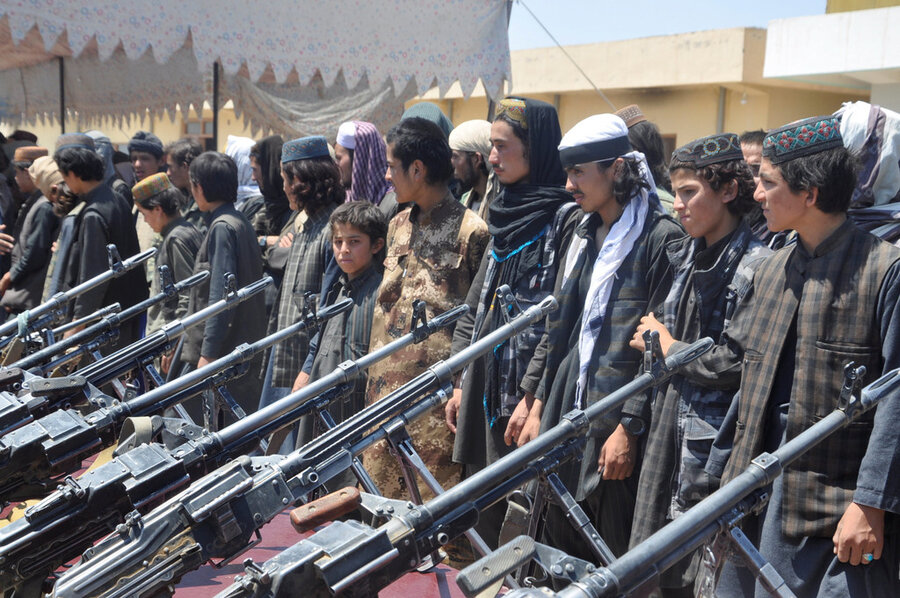An alignment for peace in Afghanistan
Loading...
Over the past year, the long war in Afghanistan has seen no strategic breakthroughs. And in fact, a major battle is now being waged in the city of Ghazni. Yet, according to some diplomats, recent moves by the United States, the Taliban, and the elected government in Kabul may offer the best hope yet for a settlement.
Such optimism rests on the US maintaining its current approach. This includes strengthening the Afghan government and its security forces while eliminating any terrorism threat, especially from the Afghan branch of Islamic State (ISIS). It also means strengthening international support for a peace deal, notably by pressing Pakistan to play a constructive role.
The US was able to increase diplomatic efforts to find a path to peace this year only after bolstering its military presence and support for Afghan forces in 2017. It is working closely with President Ashraf Ghani, who has made courageous gestures toward the Taliban and a peace process. The Taliban reciprocated in June, accepting the first truce since the fighting began in 2001. It lasted for only three days, but the break in fighting was widely welcomed by Afghan civilians and rank-and-file Taliban.
Combat resumed quickly, but the Taliban continued to talk about negotiations through various channels, including to former US officials. Those experts found the insurgents talking in different, more acceptable ways. The Taliban representatives, for example, were willing to envision the possible continued presence of international (read US) forces, and talked about the threat to Afghanistan posed by ISIS. Other specialists say some of the Taliban have also moderated their views on social issues such as education for girls and women.
In June and July, Secretary of State Mike Pompeo sent important diplomatic signals. While reiterating a firm US commitment to the Afghan government, he said the US “will support, facilitate and participate” in peace talks that are Afghan-led, a shift from envisioning only Afghan-Afghan talks, which had been the US formulation before. He also said that talks could include discussion of “international forces and actors” (e.g., US forces), which is a prime Taliban concern. Then, at the end of July, the senior US diplomat leading the work to find a pathway to peace, Alice Wells, secretly met in Qatar with a senior Taliban official.
There is still much work needed before that conversation can turn into a serious process. The Taliban continue to insist that they will only talk to the US. The US insists that an agreement can only be worked out between the Afghan government and the Taliban. The real breakthrough will be getting the two sides into the same room, even with the US participating.
Several factors can help. The temporary truce revealed a strong desire for peace. It showed that the Taliban leadership in Pakistan can exert discipline among their forces in Afghanistan, even if there are internal divisions. Also, informed observers say the Taliban are impatient with Pakistani meddling, and that they may be feeling a squeeze on financial resources flowing from Gulf Arab funders and the drug trade.
The US and Mr. Ghani have mobilized international support from the region and the Islamic world for a peace process. Importantly, the Afghan armed forces are more capable than ever before and have added punch provided by targeted US capacities and support. This makes a big pro-Taliban shift on the battlefield less likely.
There will still be plenty of skeptics and opponents to a peace process, from Pakistan’s leadership, which seeks an outcome it can manipulate, to factions within the Taliban and the Afghan government, who worry they may lose in a negotiated solution. There are also skeptics in the US who want tough “trust and verify” measures if a process begins. Yet there is also a hunger for peace evident in US and allied politics. The strategic US objective, however, remains avoiding the re-creation of an ungoverned space in Afghanistan from which terrorists can operate internationally.
Ironically, this concern could be an area for confidence building. The US, the Afghan government, and the Taliban are all fighting ISIS forces. There is a potential for “deconflicting” efforts by the three against ISIS. This common purpose could facilitate wider dialogue.
The bottom line: It is worth the demanding diplomacy to move toward a negotiated peace for a country that has suffered too many decades of war and for the US, which has committed so much to Afghanistan since 2001.







